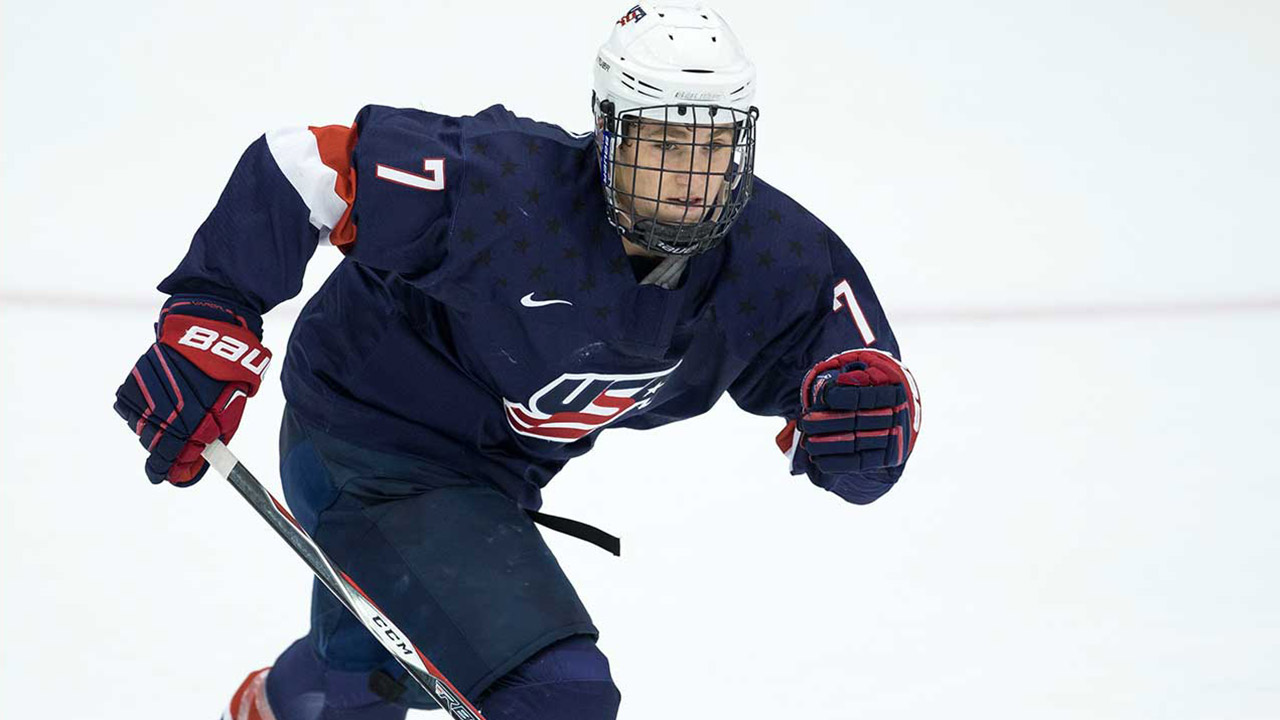Had Matthew Tkachuk been named after his father, he’d be going through life as Keith Tkachuk Jr. While that’s not the case, you’d be well within your rights to call Matthew Keith Tkachuk 2.0.
It’s not that the younger Tkachuk is necessarily an upgrade on the old man; after all, the senior Tkachuk scored 538 goals in 1,201 games during an incredibly successful NHL career. It’s really more about the way Matthew plays a game that’s reminiscent of his father’s, but includes some tweaks and turns that make it viable for today’s brand of hockey.
“He’s what I would call a modern-day power forward,” says Basil McCrae, GM of the London Knights team Tkachuk will suit up for this season.
In Keith Tkachuk’s day, he was the perfect power forward prototype. On two occasions, Tkachuk scored more than 40 goals while racking up in excess of 200 penalty minutes. But that version of a big-bodied scorer—the guy who created space through intimidation, then had the hands to snap pucks home with the extra inches of ice—has become a bit of an antiquated model. Aside from the bruises around the league that perfectly match the shape of Corey Perry’s stick blade, there’s not much evidence of hockey being played the way Tkachuk and a handful of others approached it during their heyday.
What you will find—and what every GM in the league is thrilled to uncover when he does—are a few guys like Matthew Tkachuk, who, at six-foot-one and 187 pounds, has the frame to win physical battles and fend off checkers, while still possessing the speed and hands normally associated with smaller, more nimble players.
“He scores nice goals and makes nice plays, but he’s also kind of a junk-yard dog in front of the net,” McRae says.
It was that unique combination that prompted McRae and the Knights to draft Tkachuk in the fourth round of the 2013 OHL Priority Selection. At that point, Tkachuk seemed destined to take the same NCAA route to the NHL his father did, but London—which has a history of wooing American kids who originally planned on attending college—knew it was better positioned than most clubs to be Tkachuk’s OHL home of choice if he decided to take that path.
McRae, a scrappy veteran of 576 NHL games, has deep roots in the St. Louis minor hockey system where Tkachuk grew up playing thanks to all the years his dad spent with the Blues. When McRae’s own son, Phil, was drafted by St. Louis in 2008, he lived with the Tkachuk family while training in the off-season.
With those connections in place, the Knights kept their fingers crossed that Tkachuk might reconsider his commitment to Notre Dame and come north. A trip to London last year helped seal the deal.
“It just felt right,” Tkachuk said. “I saw a game; seeing 9,000 fans, seeing how much that city loves hockey is only a bonus to having a former NHL coach in coach (Dale) Hunter and just seeing all the NHLers London has produced. I just felt like London would be the best spot to put me in the NHL some day.”
Tkachuk spent last year with the U.S. National Team Development Program under-18 squad, racking up 38 goals and 96 points in 65 games while playing left wing beside centre Auston Matthews. Like Matthews, Tkachuk is a late 1997 birthday, meaning 2016 is the first year he will be eligible for the NHL draft. While Tkachuk doesn’t figure to have too long a wait before his name is called, Matthews, who’s chosen to spend the upcoming season playing in Switzerland, is the slam dunk No. 1 selection. Skating with such a talented player made a big impression on Tkachuk last season.
“It was unlike anything I’ve ever done before,” he said. “Playing with a guy that good and that determined was just breathtaking. He’s just so skilled, so smart; his work ethic, above all else, is his biggest attribute.”
While Tkachuk might not have anybody quite as good as Matthews by his side this season, the Knights are certainly not hurting for talent. Mitch Marner, drafted fourth overall by the Toronto Maple Leafs in June, could well be back with the team, along with Arizona Coyotes 2014 second-rounder Christian Dvorak and another 2016 draft-eligible American the Knights lured to London, Max Jones. (As of the 2015 OHL draft, the Knights also hold the rights to Tkachuk’s younger brother, Brady, who missed being eligible for the 2017 NHL draft by one day and has committed to Boston University).
“I expect to win next year,” said Tkachuk, who also figures to suit up for Team USA at the World Junior Championship in Finland. “I feel like we have the team to do that, it’s just about connecting and gelling together.”
One guy who won’t be in London’s lineup when Tkachuk gets there is Max Domi, who is turning pro after spending four years with the team. Like Domi, the son of former NHL tough guy Tie Domi, Tkachuk had the benefit of being exposed to the highest level of hockey from a young age. While that offers no guarantees in terms of following in dad’s footsteps, it does create an in-the-bone understanding of what it takes to be an NHL player.
“You pick up all that little information and try to use that in your life,” says Tkachuk.
Players like Matthew Tkachuk, Max Domi and Phil McRae, who played for the AHL’s Chicago Wolves last year, all yearn to become second generation NHLers and, of course, that’s precisely what the first generation is hoping for, too.
“We all want to see them succeed and live the dream like we were able to,” McRae said.
Assuming that happens for Tkachuk, there will be some similar—yet slightly different—aspects to the way that dream unfolds.


